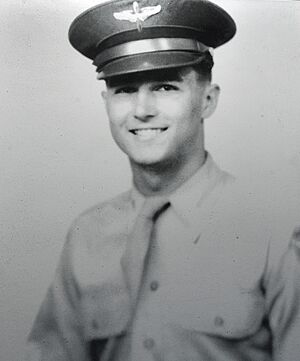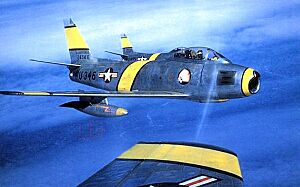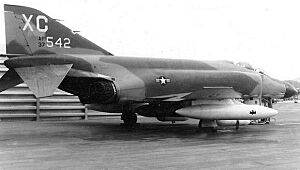Ralph Parr facts for kids
Quick facts for kids
Ralph Parr
|
|
|---|---|
 |
|
| Born | July 1, 1924 Portsmouth, Virginia, U.S. |
| Died | December 7, 2012 (aged 88) New Braunfels, Texas, U.S. |
| Buried |
Fort Sam Houston National Cemetery in San Antonio, Texas, U.S.
|
| Allegiance | United States |
| Service/ |
United States Army Air Forces United States Air Force |
| Years of service | 1942–1976 |
| Rank | Colonel |
| Unit | 49th Fighter Group 49th Fighter Bomber Wing 4th Fighter Interceptor Wing 12th Tactical Fighter Wing |
| Commands held | 4456th Combat Crew Training Squadron 4455th Combat Crew Training Squadron 12th Tactical Fighter Wing |
| Battles/wars | World War II Korean War Vietnam War |
| Awards | Air Force Cross Distinguished Service Cross Silver Star Legion of Merit (3) Distinguished Flying Cross (10) Bronze Star Medal Meritorious Service Medal Air Medal (41) |
Colonel Ralph Sherman Parr, Jr. (July 1, 1924 – December 7, 2012) was an American double-flying ace of the Korean War. He was credited with a total of ten downed enemy aircraft. He also flew in World War II and the Vietnam War, and is the only person to have been awarded both the United States Army Distinguished Service Cross and the corresponding decoration used by the United States Air Force once it became an independent branch of service, the Air Force Cross.
Contents
Early life
Parr was born in 1924, in Portsmouth, Virginia. His parents were Ralph Sherman Parr and May (Morrison) Parr. His father was a US Navy commander who served in both World War I and World War II. One of his brothers was Warren Sherman Parr, a US Navy rear admiral.
Military career
Parr enlisted in the U.S. Army Reserve on November 4, 1942, and he was accepted into the Aviation Cadet Program on February 2, 1943, earning his pilot wings and commission as a 2nd Lieutenant in the U.S. Army Air Forces at Maxwell Field, Alabama, on February 8, 1944.
World War II
His first assignment was as an instructor pilot at Blytheville Army Airfield, Arkansas, from February to September 1944, followed by P-38 Lightning transition training from October 1944 to April 1945. Parr served as a P-38 pilot in various bases in California from April to August 1945, and then served as a P-38 and then P-51 Mustang pilot with the 7th Fighter Squadron of the 49th Fighter Group on Okinawa and then in Japan from August to July 1946.
After returning to the U.S., he left active duty and joined the Air Force Reserve on September 3, 1946.
Post war
Parr was recalled to active duty on February 9, 1948. After returning to active duty, Parr served as a P-51 and then F-84 Thunderjet pilot with the 60th Fighter Squadron at Walker Air Force Base, New Mexico, and then at Otis Air Force Base, Massachusetts, from February 1948 to July 1950.
Korean War

Parr served as an F-80 Shooting Star pilot with the 7th Fighter Bomber Squadron at Furumaki Air Base in Japan, and then deployed to Korea at Taegu Air Base from July 1950 to May 1951, where he flew several ground attack missions.
He then served as an F-86 Sabre pilot with the 116th Fighter Interceptor Squadron at Geiger Field, Washington, from June to August 1951, and with the 94th Fighter Interceptor Squadron at George Air Force Base, California, from August 1951 to May 1953. Parr returned to Korea as an F-86 pilot with the 335th Fighter Interceptor Squadron of the 4th Fighter Interceptor Wing at Kimpo Air Base from May to September 1953.
One of his missions began on June 7, 1953, when he descended from 41,000 feet over the Yalu River that separated North Korea from China and saw four Soviet MiG-15s. He pursued them, firing his guns and then leveling off at 300 feet. As he rose to 4,000 feet, he spotted an additional 12 MiGs. In the following dogfight, he destroyed two MiG-15s and damaged another before withdrawing to safety.
On June 30, his flight came across 16 MiG-15s. He managed to destroy two MiGs. He then helped drive off 10 other MiGs, which were threatening his wing commander, despite low fuel. For his actions, he was awarded Distinguished Service Cross.
During the Korean War, he flew 165 combat missions and helped to develop new combat tactics for fighting MiG-15s. He managed to shoot down a total of ten enemy aircraft, all while flying F-86 Sabres in 47 missions, during the last 7 weeks of the war. He continued to serve with the 334th FIS until February 1954.
On July 27, 1953, the day of the armistice, then Captain Parr scored the last aerial 'kill' of the Korean War by shooting down an unarmed Soviet Navy Ilyushin Il-12 transport aircraft, which was flying from Port Arthur to Vladivostok through the North Korean airspace. All 21 passengers, including 3 medical staff, were killed. The Soviet Union filed a lawsuit of $1,860,000 against Parr in the International Court of Justice, however the American side denied this.
Post war
After the war, Parr served as an F-86D Sabre Dog air defense pilot with the 4750th Air Defense Group at Vincent Air Force Base, Arizona, from February 1954 to July 1958. Parr served as an Operations Staff Officer with the 73rd Air Defense Division at Tyndall Air Force Base, Florida, from July 1958 to October 1959, and then as an Operations Staff Officer with the Military Assistance and Advisory Group in the Netherlands from October 1959 to September 1962. His next assignment was as an Operations Staff Officer with the 836th Air Division at MacDill Air Force Base, Florida, from September 1962 to January 1963, followed by service as Operations Officer for the 4453rd Combat Crew Training Squadron at MacDill AFB from February to December 1963.
Parr served as Commander of the 4456th Combat Crew Training Squadron at MacDill AFB from January to July 1964, and then as Operations Officer for the 4454th Combat Crew Training Squadron at Davis-Monthan Air Force Base, Arizona, from August 1964 to January 1965.
He served as Commander of the 4455th Combat Crew Training Squadron at Davis-Monthan AFB from January 1965 to August 1966, and then attended Air War College at Maxwell AFB, Alabama, from August 1966 to August 1967.
Vietnam War
Parr then served as Deputy Commander for Operations of the 12th Tactical Fighter Wing at Cam Ranh Base, South Vietnam, from September 1967 to August 1968, flying F-4 Phantoms. He received the Air Force Cross during the siege of Khe Sanh in 1968, for destroying several mortar and machine gun positions of the Viet Cong troops in one aerial sortie. He completed seven out of eight combat approaches while flying a heavily damaged F-4, which not only impaired the hostile force's capability to impede the resupply of Khe Sanh, but also reduced further losses to friendly cargo aircraft and crews. He was nominated for Medal of Honor by the U.S. Marine Corps command in Khe Sanh.
Following the completion of his first tour in the Vietnam War, he served on the staff of the Military Personnel Group at Randolph Air Force Base, Texas, from October 1968 to March 1970. During his second tour in Vietnam, he served as the Vice Commander of the 12th TFW at Phù Cát Air Base, South Vietnam, from March to October 1970, and then as Commander of the 12th TFW from October 1970 to April 1971.
Post war
Parr served on the staff at Headquarters U.S. Air Forces in Europe at Lindsey Air Station, West Germany, from April 1971 to August 1972, and then with the Military Assistance and Advisory Group to Iran from August 1972 to January 1974. His final assignment was as Director of Operations for the Tactical Air Warfare Center at Eglin Air Force Base, Florida, from January 1974.
Parr was medically retired from the Air Force in 1976, after injuring his back while inspecting damage to the roof of his home at Elgin AFB, after a hurricane.
Personal life
He was married to Margaret Parr for 40 years. They had six stepchildren and 10 grandchildren.
Death
Parr died on December 7, 2012, at an assisted living facility in New Braunfels, Texas, at the age of 88, and was buried with full military honors at Fort Sam Houston National Cemetery in San Antonio.
Awards and decorations
Col. Parr is the only person ever awarded both the Distinguished Service Cross and the Air Force Cross.
His personal awards are:
 |
|||
| US Air Force Command Pilot Badge | |||||||||||
| Air Force Cross | Distinguished Service Cross | ||||||||||
| Silver Star | Legion of Merit w/ 2 bronze oak leaf clusters |
Distinguished Flying Cross w/ Valor device, 1 silver and 2 bronze oak leaf clusters |
|||||||||
| Distinguished Flying Cross w/ 1 bronze oak leaf cluster (second ribbon required for accouterment spacing) |
Bronze Star | Meritorious Service Medal | |||||||||
| Air Medal w/ 4 silver oak leaf clusters |
Air Medal w/ 3 silver and 1 bronze oak leaf clusters (second ribbon required for accouterment spacing) |
Air Medal w/ 2 bronze oak leaf clusters (third ribbon required for accouterment spacing) |
|||||||||
| Air Force Commendation Medal | Army Commendation Medal | Air Force Presidential Unit Citation w/ 3 bronze oak leaf clusters |
|||||||||
| Air Force Outstanding Unit Award w/ Valor device, 1 silver and 1 bronze oak leaf clusters |
Air Force Organizational Excellence Award 1 bronze oak leaf cluster |
Combat Readiness Medal | |||||||||
| Army Good Conduct Medal | American Campaign Medal | Asiatic-Pacific Campaign Medal w/ 4 bronze campaign stars |
|||||||||
| World War II Victory Medal | Army of Occupation Medal w/ 'Japan' clasp |
National Defense Service Medal w/ 1 bronze service star |
|||||||||
| Korean Service Medal w/ Arrowhead device, 1 silver and 1 bronze campaign stars |
Armed Forces Expeditionary Medal w/ 1 bronze service star |
Vietnam Service Medal w/ 1 silver and 1 bronze campaign stars |
|||||||||
| Air Force Longevity Service Award w/ 1 silver and 1 bronze oak leaf clusters |
Armed Forces Reserve Medal | Small Arms Expert Marksmanship Ribbon | |||||||||
| Philippine Liberation Medal w/ 2 bronze service stars |
Philippine Independence Medal | Vietnam Gallantry Cross w/ Bronze Star |
|||||||||
| Vietnam Armed Forces Honor Medal 1st Class |
Republic of Korea Presidential Unit Citation | Republic of Vietnam Gallantry Cross | |||||||||
| United Nations Korea Medal | Vietnam Campaign Medal | Korean War Service Medal | |||||||||
See also
- List of Korean War flying aces



